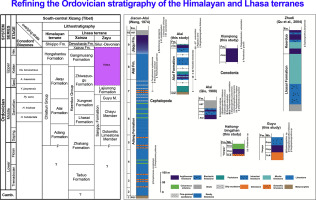当前位置:
X-MOL 学术
›
Gondwana Res.
›
论文详情
Our official English website, www.x-mol.net, welcomes your
feedback! (Note: you will need to create a separate account there.)
Ordovician successions in southern-central Xizang (Tibet), China—Refining the stratigraphy of the Himalayan and Lhasa terranes
Gondwana Research ( IF 7.2 ) Pub Date : 2020-07-01 , DOI: 10.1016/j.gr.2020.01.023 Yong Yi Zhen , Yuandong Zhang , David A.T. Harper , Renbin Zhan , Xiang Fang , Zhihao Wang , Shenyang Yu , Wenjie Li
Gondwana Research ( IF 7.2 ) Pub Date : 2020-07-01 , DOI: 10.1016/j.gr.2020.01.023 Yong Yi Zhen , Yuandong Zhang , David A.T. Harper , Renbin Zhan , Xiang Fang , Zhihao Wang , Shenyang Yu , Wenjie Li

|
Abstract The Ordovician stratigraphy of southern-central Xizang (Tibet) has been revised based on new conodont data recovered from 43 samples in four stratigraphic units and their integration with existing nautiloid and graptolite data. The Histiodella holodentata and Pygodus serra biozones have been identified respectively in the Alai and Jiaqu formations of the Chiatsun Group exposed near Alai village in Nyalam County within the Himalayan terrane, and the Yangtzeplacognathus foliaceus Subbiozone (lower part of the Pygodus serra Biozone) in the Sangqu Formation exposed at the Guyu section within Zayu County in the Lhasa terrane. Recognition of these biozones has increased the precision of correlation of the middle-upper Darriwilian strata in the region. Regional reassessment of the Ordovician stratigraphy permitted by new biostratigraphic data has allowed revised definitions for the Chiatsun and Keerduo groups and the Sangqu and Xainza formations. The Chiatsun Group is defined herein to include three lithologically distinctive formations in descending order, the Jiaqu, the Alai and the Adang formations. The stratigraphic age for the Jiaqu and Alai formations in the type area ranges from the middle Darriwilian (Histiodella holodentata Biozone) to middle Katian (Hamarodus brevirameus Biozone), but the age of the Adang Formation remains less certain.
更新日期:2020-07-01











































 京公网安备 11010802027423号
京公网安备 11010802027423号